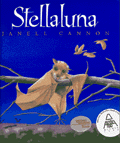 This teacher's guide will help you in your instruction of Jannell Cannon's Stellaluna. Separated from her mother before she is old enough to fly, Stellaluna, an adorable baby fruit bat, finds her world turned literally upside down when she's adopted by a family of birds. |
Activities
Internet Resources
Books by Jannell Cannon
Stellaluna Extension Activities
Prereading Activities:
Word Web
Before reading Stellaluna have the children do a word web on bats. Be sure that emotions elicited by bats are included as well as physical descriptions. Share the information from the ''Bat Notes'' at the back of the book, including the fact that there are two major types of bats and nearly a thousand different varieties. Ask the children if they think that the words they generated in the web would apply to every variety of bat.
Batty Ideas
Share the front cover of the book and discuss whether the illustration conforms to the children's previous ideas about bats.
Postreading Activities:
Imitation
In Stellaluna one species of animal is asked to imitate another. Pair the students together and have them work on imitating an animal (actions and sounds). Have the groups demonstrate their imitations for the class and let the class guess the animal being depicted.
Word Web Recheck
Look again at the word web before reading. Do the children want to change it in any way?
Discussion Points:
- Discuss the friendship between Stellaluna and the birds. Possible questions to ask: Will this friendship last? What obstacles might there be to continuing the friendship?
- Discuss what might have happened to Stellaluna and the birds if Stellaluna had not found her mother. Possible questions to ask: Would Stellaluna have tried to continue behaving like a bird? Would the birds have tried to behave like bats? Would Stellaluna have returned to her bat ways as she got older?
- Ask if the children's feelings about bats have changed since reading this book. How do they feel about owls, typically? Discuss the owl's role and image in this story.
- Talk about stereotyping and how the seemingly bad actions of a few can lead to labels for a whole group. Remind the children to keep this in mind when they hear negative things about any group.
Negative to Positive
In cooperative groups pick an animal that is often thought of negatively (snakes, rats, owls, bats). Tell the students that they must tell or draw a story that will change people's feelings about this animal.
Fact not Fiction
After reading the ''Bat Notes'' at the back of the book, have small groups of children choose one of the two major categories of bats and do poster reports. Their posters should include the bat's scientific name, habits, habitat, usefulness to humans, and a picture of the bat. Or have them select a specific species of bat and do further research. Or have the children present their findings to a younger group of children. Make drawings and slogans and display them in your local library, classroom, or even your local zoo. Some bats navigate by echolocation. Have the children research radar and discuss how radar and echolocation are similar. Discuss the fact that all bats have come to be feared based on mostly erroneous stories about the vampire bat, of which there are only three species out of nearly eight hundred varieties of Microchiroptera.
To order books or Creative Curriculum Connections, contact your local bookstore or distributor or call Harcourt Brace Customer Service toll free: 1-800-543-1918.
Trade Division
Children's Books Marketing Department
525 B Street
San Diego, California 92101
(619) 699-6435










